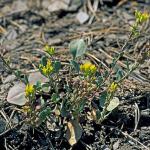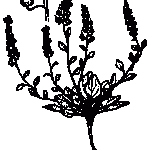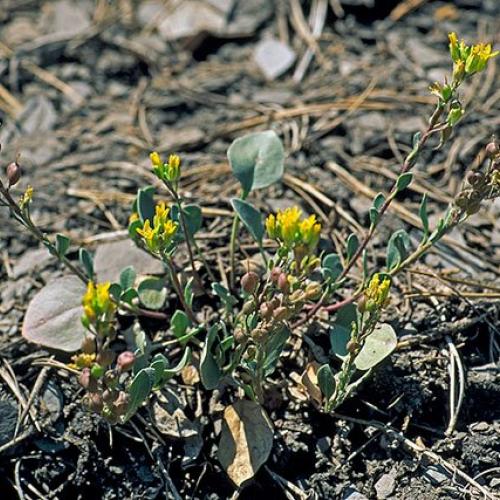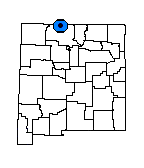Description
Perennial, more or less densely pubescent with closely appressed more or less stellate trichomes, these 0.2-0.3 mm in diameter, sessile or substipitate, smooth or finely granular, rays 4-7, distinct but stout and usually contiguous at their bases and thus scale-like, forked or bifurcate; stems to 2 dm long, decumbent or erect, arising from a simple or divided woody caudex; basal leaves 4-8 cm long, 11-17 mm wide, blades suborbicular or obovate to rhombic, entire to sinuate or shallowly toothed, narrowing abruptly to the long petiole, abaxial surface with dense and overlapping trichomes, adaxial surface with trichomes often barely contiguous; stem leaves 0.8-2.3 cm long, 2-11 mm wide, obovate to rhombic, entire to shallowly toothed, the lower ones petiolate, those above sessile, pubescence as on the basal leaves; inflorescences dense; buds large and ellipsoid; sepals about 6 mm long, the lateral ones elliptic, cucullate, not saccate or barely so, median sepals oblong, cucullate, thickened at the apex; petals about 9 mm long, yellow, spathulate and expanded at the base; filaments slightly expanded in their proximal half, paired stamens about 7 mm long, single stamens about 6 mm long; glandular tissue + completely surrounding each single stamen (thickened on the lower side) and subtending the paired stamens but not developed between the latter; infructescences elongated and dense; pedicels 8-11 mm long, stout and expanded at the summit, sigmoid and + horizontal to the axis or slightly curved and spreading; silicles 6-9 mm long, sessile or substipitate, globose or ellipsoid (then sometimes slightly obcompressed), valves inflated and rather thin, peaked at the apex, glabrous within and without; septum entire, very little wrinkled, funicles attached 1/3 or less their lengths; styles 3.5-7.0 mm long, slender, stigmas slightly expanded; ovules 2-4(6) per locule; seeds 2.5-3.0 mm long, suborbicular to oblong (a little broader than long), somewhat flattened, orange-brown, neither margined nor winged; cotyledons accumbent, about twice as long as the radicle (Rollins and Shaw 1973). Flowers May to August.
Similar Species
Not likely to be confused with other species in the same habitat.
Distribution
New Mexico, Rio Arriba County, near Colorado border; Colorado, Archuleta County.
Habitat
Limited to soils derived from the upper cretaceous Mancos Shale Formation; 2,095-2,514 m (6,810-8,250 ft). Occurs in patches in a 10 by 40-mile band (northwest-southeast) within the Archuleta uplift. The highest densities tend to be on exposed gray clay barrens surrounded by montane grasslands. Smaller populations are found in open ponderosa pine stands and gambel oak communities with the numbers apparently decreasing when plants become part of the forest understory. Physaria pruinosa can also be associated with Douglas fir and Engelmann spruce communities at the upper limits of its range.
Conservation Considerations
An inventory of potential habitat in New Mexico is needed to determine if current land uses pose a threat to this plant. Residential growth and development are the main threats in Colorado.
Important Literature
*Anderson, J.L. 1988. Status report for Lesquerella pruinosa. Unpublished report prepared for the U.S. Fish and Wildlife Service, Golden, Colorado.
*Colorado Rare Plant Technical Committee. 1997. Colorado rare plant field guide. Prepared for Bureau of Land Management, U.S. Forest Service, and U.S. Fish & Wildlife Service by the Colorado Natural Heritage Program, Fort Collins.
Al-Shehbaz, I.A. and S.L. O'Kane, Jr. 2002. Lesquerella is united with Physaria (Brassicaceae). Novon: A Journal for Botanical Nomenclature from the Missouri Botanical Garden 12:319-329.
*Anderson, D.G. 2006. Lesquerella pruinosa Greene (Pagosa bladderpod): A technical conservation assessment. [Online]. USDA Forest Service, Rocky Mountain Region. Available: http://www.fs.fed.us/r2/projects/scp/assessments/lesquerellapruinosa.pdf [accessed September 2011].
\





